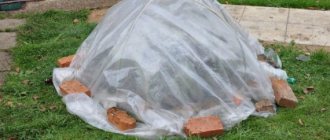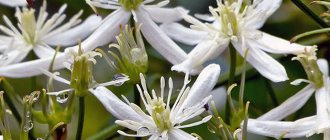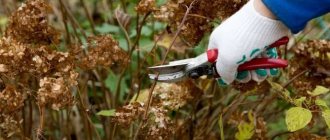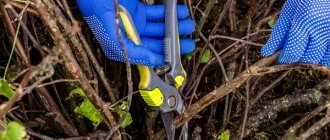We all love luxuriously blooming clematis. New varieties appear every year, which indicates the growing popularity of this vine. For successful cultivation it is necessary to have theoretical and practical knowledge. First of all, you need to know about the existing pruning groups into which these plants are divided. You should definitely check this when purchasing a plant at a nursery (garden center) or find it on the Internet or in literature by name. In this article we will tell you about preparing clematis for winter.
Three pruning groups for clematis
Self-identification of the clematis group
Recommendations for pruning clematis
Pinching shoots of clematis
Pruning weakly winter-hardy varieties
Preparing clematis for winter by region
Sheltering clematis for the winter
Photo: Blooming vines in the garden.
general information
Due to their stunning appearance, clematis can even compete with rose bushes, orchids or other lush flowers. But many gardeners refuse to plant this vine, for a simple reason - it is too capricious and picky about its conditions . The main difficulty of growing lies not only in specific care, but also in the need to prepare the crop for wintering. For a plant to survive in the middle zone, it needs to be provided with reliable shelter. It is created taking into account climatic characteristics and varietal characteristics of clematis.
Autumn care and preparation for winter are closely interconnected, so you need to start preparatory work in August. If care is not adjusted and appropriate measures are not taken, the magnificent steeplejack will not be able to survive the onset of cold weather.
At the preparatory stage, it is necessary to carry out the following activities:
- At the beginning of August, you should reconsider the regime of fertilizing the soil, abandoning nitrogen-containing compounds, as well as mineral mixtures containing this element.
- In September, all varieties of vines are fed with phosphorus-potassium fertilizers, which promote rapid ripening of shoots, as well as the effective development of immunity before winter.
- A couple of weeks before the onset of persistent cold weather with temperatures below 10 degrees, you should begin pruning activities.
The process of preparing for wintering consists of several stages. Among them:
- Trimming.
- Treatment.
- Insulation.
It is important to have time to carry them out long before the cold weather arrives, preferably at the end of August or beginning of September. In the autumn, the bushes and the soil around them are treated with foundationazole diluted in 10 liters of water, as well as wood ash. The soil around the vine is thoroughly loosened to a depth of 15 centimeters, and the bush itself is covered with peat, humus or compost.
Sheltering clematis for winter in the Moscow region
Like other garden plants, covering clematis can be done in different ways, only for Siberia you need to use more layers of material than for the Moscow region or Leningrad region. The shelter should be made based on the group of colors:
Groups I-II (last year's shoots). These shoots need to be preserved, so they are carefully rolled into an arc and pinned to the ground. Cover the top with spruce paws and dry leaves. Roofing felt or film is laid as the topmost layer. The edges are pressed tightly.
Group III (young shoots). These short-cut shoots are the easiest to cover. First, like other groups, they are sprinkled, and a wooden box is placed on top. Material is thrown onto the box.
Before covering, all clematis are covered with sand and covered with peat, humus or sawdust up to 25 cm high. With the onset of spring, the shelter is gradually removed. First, the film or roofing material is removed, and when the danger of night frosts has passed, the spruce branches are removed. So, layer by layer, the plants are released, giving them time to harden a little. Then the shoots are carefully straightened and pinned to the support.
Types of pruning
If you are interested in the intricacies of preparing clematis for winter, you need to understand the existing types of autumn pruning. Such activities are intended for the normal development and formation of the root system. Depending on the purpose, pruning can be:
- Sanitary - involves cleaning the crop from damaged or dead vines.
- Formative - used to give shape to the bush, improve metabolic processes and growth of flower stalks.
- Winter - allows the bushes to cope with winter cold and strengthens resistance to freezing.
If you trim such a garden plant in time, this will greatly simplify further preparation for cold weather and protect it from frost. In addition, correct implementation of the procedure is the best stimulation of rejuvenation of old shoots. With the arrival of spring, young shoots will grow on them, on which flower buds will form.
Pruning clematis in autumn
Autumn pruning of clematis should be done correctly, taking into account the flowering characteristics of various varieties of this flowering perennial, so that next season the clematis will delight your eye with its active flowering.
When to prune a plant in the fall? As a rule, it is optimal to prune shortly before the onset of cold weather.
The clematis pruning procedure includes the following varieties:
- sanitary, in which all damaged or dried branches are removed, as well as all dried flowers;
- thinning, in which branches that overly thicken the bush are cut out.
- shaping, in which clematis are given a certain shape that improves their growth and flowering;
- winter (for shelter), in which these plants tolerate cold periods better and freeze out less.
In our case, we will talk specifically about the last type of pruning, although it partly combines all other types of pruning. It is clear that by pruning these flowering vines before the onset of frost, it will be easier to cover them for the winter. Therefore, it is quite clear why clematis should be pruned in the fall in preparation for winter. In addition, such pruning rejuvenates the flower, and in the next season new shoots with flowering buds appear (not in all species).
Important! You can get detailed information about pruning clematis this detailed article .
When is it better to prune clematis - in autumn or spring?
Winter pruning, as the name implies, is carried out in late autumn, before the onset of frost. But formative and sanitary types of pruning can be carried out both in spring and early autumn. But all types of pruning should be carried out taking into account the biological characteristics of the varieties of these climbing vines.
How to prune clematis correctly depending on the type
Based on the characteristics of the formation of flower buds on the shoots of these vines and subsequent flowering, clematis are divided into three main groups.
The first of them (pruning) includes vines, the buds of which appear on the shoots of the previous season. Most often, the following clematis varieties of this group are grown in garden plots: Hegley Hybrid, Turk, Cardinal Rouge, Armanda, Montana, Wesselton, Frankie and others.
In clematis from the next (second) group, from May until the second ten days of July, buds bloom on the shoots of the previous season, and from the second half of July, flowers appear on the side stems that have grown in this season. The most popular varieties are Dawn, President, Fair Rosamund, Flower Ball, Minister and some others.
The third group includes varieties whose buds appear only on the shoots of the current season. The most popular types of clematis of this group are Ville de Lyon, Cosmic Melody, Victory Salute, Tuchka, Gipsy Queen and other varieties of the Integrifolia, Jacquemman and Vititsella groups.
Varieties of vines from the first and second groups, the flowers of which appear only on last year's stems, should be carefully pruned - usually the strongest shoots of this year are left, on which buds will appear next season. At the same time, sanitary pruning is carried out, during which all dry, broken or damaged stems are removed.
Since the plant’s foliage does not fall off on its own (even when dried), it should also be removed in the fall when pruning shoots. Those stems that bloomed this season are reduced by about a third of their length.
But clematis belonging to the third group are cut off almost completely , leaving shoots no more than 20-30 cm long, on which there are 2-3 buds. Next season, main and side shoots will grow from them, on which beautiful flowers will appear.
Varietal features
The need for pruning depends on the timing of flowering, as well as on the varietal characteristics of the clematis. Winter care, including pruning procedures, is carried out according to the following principles:
- Plants that bloom only on the current year's shoots require comprehensive autumn pruning. These include the varieties Jacqueman, Viticella and Integrifolia.
- Clematis, which bloom on last year's shoots, do not lend themselves to formative pruning, but are only cleared of dead, diseased or rotten branches. When processing such a crop, you need to leave shoots and flower buds for the next season. Among these plants are vigorous varieties, as well as various forms of mountain, alpine and golden clematis.
- Varieties that bloom twice a season are pruned slightly. However, such a procedure is mandatory when preparing for wintering. Representatives of the Lanuginosa and Florida groups are amenable to pruning.
But gardeners have differing opinions regarding pruning the second and third types of plants. On the one hand, there are exceptions among different groups of clematis, and on the other, most varieties that supposedly bloom only on last year’s shoots are capable of blooming on both young and overwintered branches.
In any case, all varieties require regular sanitation and cleaning of dead, diseased or wilting shoots. Regardless of the type of flowering and autumn formative work, all bushes are amenable to the following procedures:
- Removing and harvesting all dry leaves, followed by destruction away from the vine.
- Removing dry shoots.
- Removing damaged branches that show signs of serious disease, as well as weak or low-productive shoots.
The specifics of pruning varieties that bloom on the shoots of the current year differ in different principles. For example, representatives of the Vititsela or Jacqueman group are cut off to almost the entire length of the aerial part. The gardener needs to leave only short stumps, just above the soil level.
How to properly cover clematis step by step
The issue of wintering clematis must be approached individually, taking into account not only the climate zone, but also the need for insulation of a particular plant. An adult, fairly winter-hardy bush can be covered directly on a support, but just in case, such plants are hilled higher (to a height of 40 centimeters). In this case, even if the lashes freeze, the root and root zone of the plant will remain, which will give it the opportunity to recover.
Young bush
Young clematis always require more care than mature and strong ones. The shoots of a young vine in a winter with little snow can freeze even with slight frosts. Experienced gardeners usually use one of the following methods to insulate young clematis:
- Plants that have been heavily pruned are first hilled up and then covered with a mulch layer of dry leaves or spruce branches. The structure is covered with a film on top to protect it from moisture. During thaws, the film shelter is raised from the sides for ventilation.
- Another method involves using inverted flower pots to cover the bushes after pruning. A layer of pine needles, sawdust or wood shavings is poured over the shelter, and after the first snowfalls, the resulting mound is covered with snow mass.
- The easiest option is to mound the clematis pruned before wintering high with peat, humus or compost. Before using organic matter, the bush and the soil near it must be treated with Fundazol to protect against fungal diseases.
It is the first wintering that is decisive and the most difficult for the plant. In the future, having adapted to the local climate, the vine will be more resistant to adverse conditions.
Proper shelter for clematis before winter: video
Which clematis can not be covered
Beginners are often afraid of heat-loving crops because of the need to cover them and the fear of doing something wrong. They can be advised to do one thing - not to plant initially difficult-to-care varietal clematis.
For inexperienced summer residents, plants of the 3rd pruning group that bloom on the shoots of the current year are quite suitable. On the eve of frost, the plants are cut short and covered with dry soil. The advantages of these clematis include not only ease of care. Such varieties are in no way inferior to their more capricious relatives in their ability to decorate the garden with abundant flowering, and sometimes even surpass them.
Shelter for the winter
Every caring gardener needs to know how to cover clematis for the winter in the Moscow region. This procedure has a lot of similarities with covering grapes, and the only differences relate only to the timing. The flower warms up much later than the vine, usually at the end of October or beginning of November. And residents of the southern regions can postpone the event even to the end of the autumn season.
Despite their capricious nature, clematis are able to tolerate severe temperature drops, but only for a short period of time. If you do not cover in time, open shoots will be damaged by frost.
Before carrying out insulation work, it is necessary to get rid of excess branches and also treat the crop vines. Gardeners use different insulation methods, which are selected taking into account various factors. The following options can be used as thermal insulation materials:
- Peat.
- Sawdust.
- Dry leaves.
- Artificial heat insulators.
You can pour dry soil on top of the insulating layer, and when snow falls, add as much snow cover as possible. At the same time, excessively dense insulation should not be allowed, since the plant must receive air even in winter. If you do not follow this rule, by the time spring arrives, clematis may collapse and die.
Methods for insulating garden vines directly depend on its varietal and the characteristics of the formation of flower buds. If flowering occurs on last year's shoots, you need to pay attention to the degree of frost resistance of the variety. Frost-resistant varieties that are able to withstand winter without being removed from their support are in particular demand. Nevertheless, the plant needs autumn hilling, which will prevent the roots from freezing during severe frosts. The height of the peat or earth slide should not exceed 40 centimeters. In this case, the insulating material used must be dry, otherwise putrefactive processes will develop in it.
If flower stalks form on young and last year's shoots, after pruning they need to be removed from the supports and hilled up. The shoots are carefully rolled into a ring, fixed to the soil, and then sprinkled with dry leaves. Also, a layer of lutrasil or agrofibre is placed on top of the resulting slide.
Preparing clematis for winter in the Moscow region
In the Moscow region, clematis have to be covered for the winter and quite thoroughly. With the onset of stable frosts or a little earlier, the bushes are hilled with dry peat or fertile soil to a height of 10-15 cm. Partially cut shoots are removed from the trellises, carefully laid on a support 10-15 cm high or spruce branches, pinned to the ground in arches, covered with spruce branches, brushwood, and then with some kind of waterproof material, which is pressed down with boards or stones so that the wind does not blow it away. Snow will complete the work of covering, but in winters with little snow it has to be collected from the paths and additionally added to the plants, especially to the base of the bushes.
Before winter, the site is dug up deeply, incorporating organic and em-fertilizers into the soil. Clematis can tolerate severe frosts. It is recommended to cover them in areas where roses cover. If the bases of their shoots are buried 10, 15 cm, then only in more northern zones after pruning the plants are covered with earth, peat, sand, covered with spruce branches, snow or other materials, with a layer up to 20-30 cm thick, thanks to which they tolerate frosts of up to 30 -40 degrees Celsius, thanks to which they tolerate frosts down to -30, -40 degrees below zero. If it is necessary to preserve shoots of species, varieties and forms that bloom on last year's growth, they are removed from the support, shortened to 1.0-1.5 m, laid on the soil and covered. In spring, clematis open gradually as warm weather approaches.
Young plants
In addition to caring for old plants, every gardener should know how to prepare clematis for winter, which is 1-2 years old. To preserve the crop from freezing in the open ground, you need to observe the following measures:
- With the arrival of autumn, the vines are cut off, and only 3-4 buds are left on the shoots. Moreover, the intensity of pruning remains the same for all varieties and methods of forming peduncles.
- The bush is covered with branches, as well as polyethylene, which will protect it from excess moisture. Before this, a mound of earth is poured over it.
- A small young clematis is covered with a large flower pot, on top of which spruce branches, wood shavings or sawdust are placed.
As for the specific care of clematis during the winter cold, it will not be needed with proper and timely shelter. However, if the temperature drops to critically low levels and there is no snow, you will have to cover the bushes with any insulating material, preferably spruce branches or hay.
We also cannot exclude the possibility of small rodents, usually mice, appearing under cover. If traces of their vital activity appear near clematis, it is necessary to scatter seedlings nearby or install mousetraps. Otherwise, rodents will destroy healthy flower sprouts.
What does autumn care for clematis include?
Caring for clematis in the fall is a set of agrotechnical measures aimed at preparing the bushes for hibernation.
It necessarily includes pruning (sanitary and decorative), fertilizing with potassium-phosphorus mineral fertilizers, watering, spraying with fungicides and insecticides, and insulation for the winter.
If necessary, in the fall you can rejuvenate the bush, plant clematis and propagate.
Each of these stages of preparation for winter is very important and performs its own specific function.
Removing thermal insulation
You can start removing cover from bushes when the warm season returns, even if there is a risk of a return of night frosts. The real problem for the plant is excessive moisture or unexpected thaws. Such phenomena cause damping off of the sprouts due to the lack of fresh air. In most cases, the insulating layer is removed in April, but not all at once, but a small part, continuing the opening procedure until May. Clematis must gradually adapt to new conditions and begin active recovery after winter.
The process of removing the cover occurs in several stages, which are divided by days. The first step is to open the ventilation holes, making sure that the air temperature is consistently comfortable. You can remove the polyethylene and the upper part of the insulation after the arrival of stable heat, when the risk of night frosts or snowfall is completely eliminated.
But don’t rush to remove the hilling layer. The plant must undergo full adaptation to the new environment and only after a couple of days can the mound be removed. The remaining soil is removed only after the threat of repeated frosts has passed. Often in the spring, a gardener discovers that the flower was unable to survive the winter and has disappeared. But this does not mean that you need to dig up the root as quickly as possible, since it is quite possible that in a few years it will recover and produce healthy shoots. This can be facilitated by the activation of dormant kidneys.
If clematis shows no signs of life during the summer season, it must be reliably insulated in winter. With the arrival of spring warmth, it can sprout. Some gardeners replant clematis after removing the cover in the spring to a new location. It should be sunny and protected from shade with fertile soil.
Before planting the plant in new soil, you need to deeply loosen it. This measure is necessary for good drainage, which will be a good stimulation of productive growth and development of the crop. It is imperative to install trellises that will act as a support for the rapidly growing vine.
Shelter for plants blooming on the shoots of the current year
Clematis, which are almost completely pruned, do not require careful covering; hilling is more important for them. To prevent the plant from getting wet, it is necessary to create layers-hills of great height. Three to four buckets of hilling material (humus, compost, peat) are poured under each bush.
If there is a little snow in winter, add it to the clematis, adding more volume to the mounds. If there is no snow at all, you can replace it with spruce branches. If the flower is very young and not resistant to frost, it can be additionally covered with a box, covered with leaves, or wrapped in film, agro-fabric or a bag.
Clematis shelter in the diagram
Useful tips
In the spring, clematis needs to be provided with balanced care, which will allow it to quickly restore strength after a long winter, start metabolic processes and begin to form new shoots. In spring, the crop needs to be watered abundantly and also fed with all kinds of mineral or organic fertilizers. They must contain a lot of nitrogen, potassium and phosphorus, as this is necessary for gaining green mass and rapid growth.
Clematis are the most beautiful garden flowers that surprise gardeners with their unsurpassed beauty and long-term flowering. But, like other representatives of exotic flora, they are a rather capricious plant with high requirements for living conditions. Therefore, before you buy seedlings and plant them in private gardening, you need to make sure of their winter hardiness and ability to grow in the conditions of the middle zone. Varieties such as Leningradsky, Cardinal and Clematis Beata are excellent for such terrain.
To grow healthy and beautiful clematis in the garden, you need to properly care for them, as well as do all the procedures regarding pruning, storing in winter, opening in spring, and so on. In this case, the liana will thank the grower with unrivaled flowering and good health.
At what temperature should clematis be covered for the winter?
Beginning gardeners are often concerned about the question: when is it necessary to cover clematis? It is worth noting that most varieties of this flowering vine are quite cold-resistant, so they should be covered after the onset of stable cold weather (at -5 -7 degrees).
As a rule, in the Moscow region these dates occur in the second half of October, in the Urals and Siberia - 1-2 weeks earlier, but in the southern regions - in the second half of November. An additional signal for the start of insulation will be yellowed and withered foliage, indicating that the plant has stopped growing and is ready to enter a dormant state.
Feeding clematis in the Urals
The first feeding of this plant is done during planting, when you add compost and superphosphate to the soil; sometimes you can use dolomite flour. In the first years of clematis’ life, you should not overfeed with fertilizers, and in subsequent periods, fertilizing should be done regularly. During the active growing season of clematis, it is necessary to apply nitrogen fertilizers, which promote foliage growth. During the formation of buds, it is better to use potassium fertilizers, and after flowering, fertilize them with phosphorus fertilizers. You can also use a solution of dolomite flour in the spring to prevent the occurrence of diseases. Before the onset of cold weather, feed your clematis with complex mineral fertilizer.











